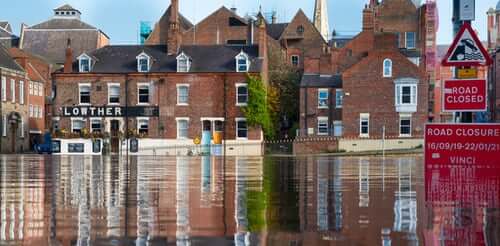A Flood Risk Assessment (or FRA) is a dedicated flood report detailing what flooding risks a building or development site is most vulnerable to. These reports must always be conducted by a qualified Flood Risk Assessment consultant, who will build a report of the site, identifying the target “at-risk” areas, whilst recommending preparatory actions that can be taken in order to minimise the impact of any potential flooding that might occur.
A considerable percentage of the UK is currently at risk of flooding; whether from groundwater, sewer, dams, tidal factors and rivers. When developing and building on any site, it is important to understand whether the area is at risk of flooding and the necessary steps that have to be taken to help reduce the impact of this.
When a site is being developed, refurbished or otherwise worked upon, the risk of flooding to that area may well determine the schedule of works. This will also affect any additional work needed and money to be spent protecting the property site from water damage as well as whether the works go ahead at all based on the risk factors that are present.
How Does a Flood Risk Assessment Work?
An FRA is a type of report that assesses how ‘at-risk ‘an area is from flooding; what type of flooding it is most at-risk of, and measures that can help to minimise or even sometimes altogether avoid the damage to the area if flooding were to occur.
Developing a site in a certain area can make some of its surroundings more prone to flooding; with the physical structure of the site affecting where the flood water may be directed towards. Therefore, some of the most important factors to consider for Flood Risk Assessments include ensuring the site is safe and can be for its lifetime, and that the site is also beneficial for other buildings, developments and sites surrounding it.
An FRA therefore takes into consideration how any [significant] flooding will affect people within the area; where they will be temporarily relocated to, and how they will come into contact with the floodwater and the effects of such contact. One of the most vital components of these assessments is to determine not only the impacts that flooding will have on the site, but also how the site will affect a flood-prone area; will it make it better or worse?
Who Needs a Flood Risk Assessment?
A Flood Risk Assessment is typically required for all developments that are located in one of the flood zones. These zones include the following:
- Flood Zone 1 – If site is over 1 hectare
- Flood Zone 1 – If the Environment Agency has notified that the site has critical drainage problems
- Flood Zone 1 – If the site is under 1 hectare and includes a “change of use in development type to a more vulnerable class”. For example, changing to a residential site
- Flood Zone 2 – For both change of use and minor development
- Flood Zone 3 – For both change of use and minor development
Whilst those listed above are the main areas that FRAs apply to, there can be other circumstances in which this type of assessment is required. For example, an FRA may be required for development sites that are located near a large or ‘main’ river, for example the river Don in Doncaster.
The details of whether a site will need assessment or not can be subject to its unique circumstances.
How to Check a Site for Flood Risks
The UK government with the Environmental Agency (EA), have developed a method for development projects to check whether chosen sites are in a zone at risk of flooding, in the form of two different maps:
- Flood Map for Planning
- Long Term Flood Risk Map for England
Checking a site’s location with these two tools can help developers to both understand the potential flooding risks associated with their chosen area, and the required assessments needed for development to continue.
Landlord Obligations for High-Risk Flood Areas
Landlords are largely responsible for the variety of different damages that can occur to their rented property as a result of flooding. Two main costs that landlords can be held liable for when flooding occurs include:
- Repairing/ replacing any damages to water, gas, heating and electricity
- Repairing damage done to the physical structure of the home
When flooding occurs, it’s essential for tenants to notify their landlords as soon as possible. If a tenant cannot move safely about their homes due to the flooding and the necessary repairs going on as a result of it, many landlords can temporarily reduce the rent whilst this is going on.
What if I am a Tenant in a Property at Risk of Flooding?
Many tenancy agreements will contain a clause in which the landlord is responsible for the property’s building and structure. Furthermore, the landlord will more often than not be liable and responsible for any circumstances in which the property becomes uninhabitable for any period of time as a result of disasters such as a fire or a flood. Landlords should have buildings insurance, which will often cover the rent lost if a house becomes uninhabitable.
It is therefore wise for landlords who own properties in any high-risk areas to take out specific insurance, if their buildings policy does not cover flooding (more information about contents and buildings insurance). As well as caring for the tenant(s) in question, these actions will help to financially support the property owner should any flooding occur. Flood Re is a scheme that helps homes in high-risk areas to take out affordable covers in the event of a flood damaging a property.
How Do I Get a Flood Risk Assessment?
Once a site has been established as needing an FRA, a consultant can be enlisted to carry out the assessment. There are numerous different businesses that offer flood risk assessment services; however, it is vital to ensure they are reputable and properly qualified to carry out the assessment.
When looking for a reputable business to conduct a flood risk assessment, checking for any reputable affiliations and other credentials can be important to ensure that the assessment is done correctly.
It is also important to ensure that the FRA is conducted within the requirements for the area. Therefore, thorough research should be done into the site’s location, and all the regulations that must be met when dealing with FRAs.



